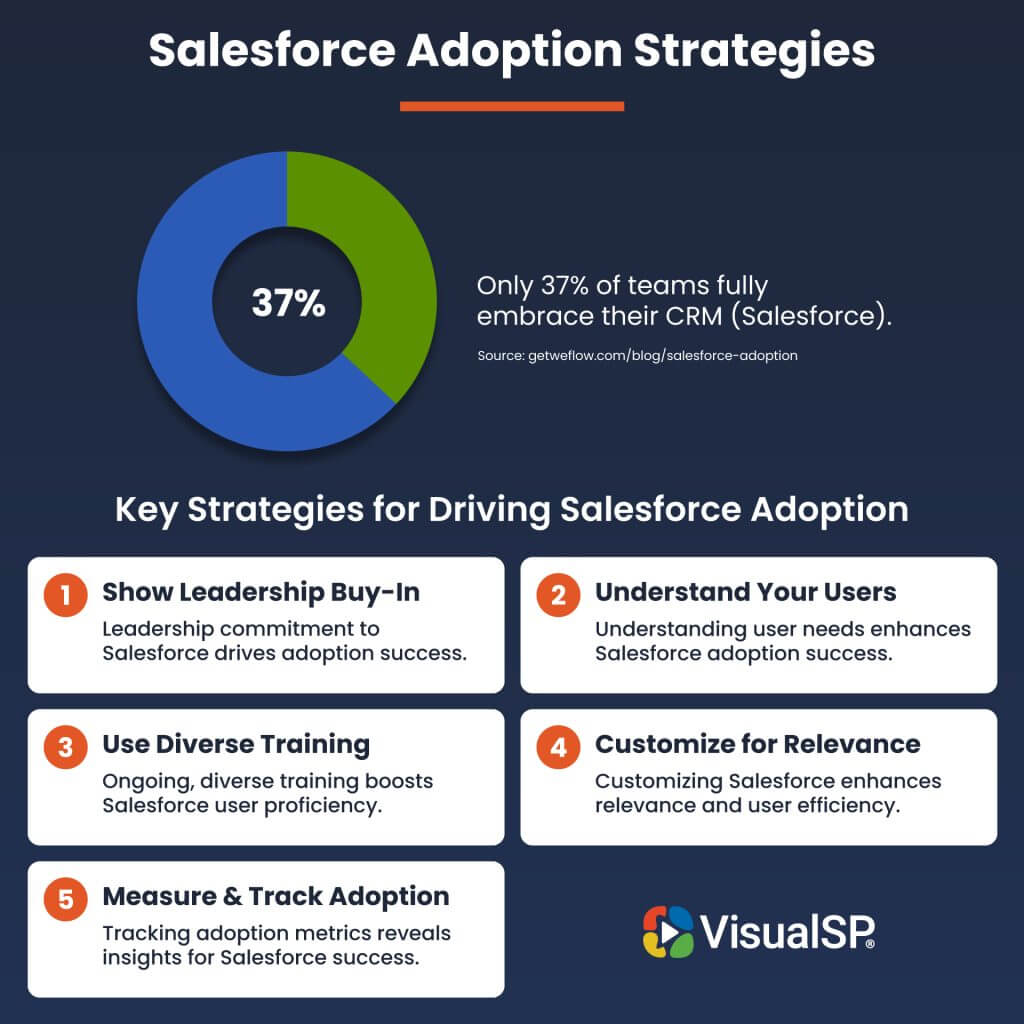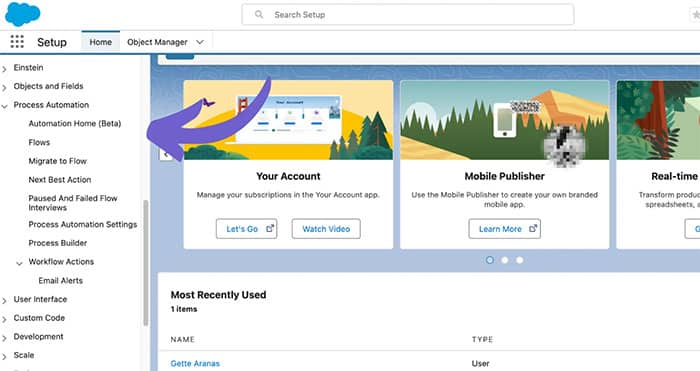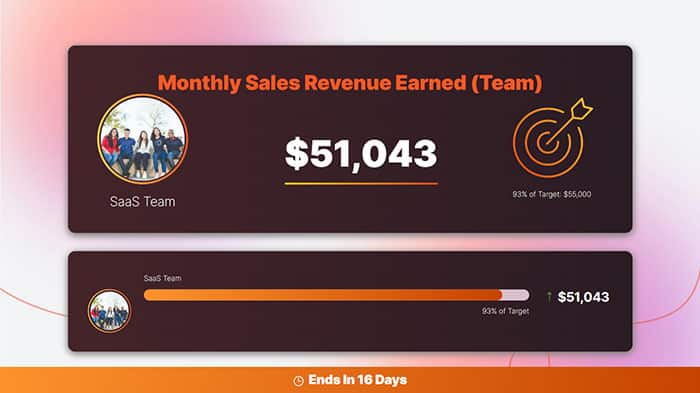Salesforce is a powerhouse CRM platform that has revolutionized the way businesses manage customer relationships. It offers a unified solution that connects departments, streamlines workflows, and enhances communication across organizations. Its capabilities make it a valuable tool for businesses of all sizes and industries.
Despite its robust features, many companies face challenges when it comes to fully adopting Salesforce.
These challenges can prevent businesses from realizing the platform’s full potential, leaving valuable tools underutilized and teams disengaged.
This article explores practical strategies to improve Salesforce adoption.
By addressing common obstacles and fostering engagement, businesses can unlock Salesforce’s full value, empowering teams and driving organizational success.

What is Salesforce?
Salesforce is a comprehensive customer relationship management (CRM) platform that integrates all business functions to provide a unified view of customers. It offers tools and solutions that allow companies to:
- Craft engaging, personalized marketing campaigns.
- Enhance sales productivity and boost revenue.
- Track customer interactions seamlessly.
- Automate redundant administrative tasks.
- Deliver consistent experiences across B2B and B2C channels.
- Leverage AI for smarter personalization.
- Manage multichannel communications through a single dashboard.
- Build custom apps easily.
By centralizing operations, Salesforce enables employees to collaborate more effectively and engage with customers as one cohesive entity.
Why is Salesforce Adoption Challenging?
Despite its advantages, Salesforce adoption can be challenging. Key hurdles include:
Salesforce adoption strategies play a crucial role in overcoming these challenges.
By implementing effective Salesforce adoption strategies, organizations can ensure that their teams fully utilize the platform’s capabilities, leading to increased user productivity and better business outcomes.
A successful Salesforce adoption strategy involves understanding user needs, providing adequate training, and continuously monitoring Salesforce adoption metrics to identify areas for improvement.
Integrating Salesforce into daily workflows can also be a significant challenge. Many sales teams struggle with incorporating Salesforce tasks into their existing processes, which can lead to incomplete and inaccurate data.
To address this, it’s important to streamline record creation and update Salesforce records regularly, ensuring that data quality is maintained.
Implementing data validation rules can help in maintaining high data quality, which is essential for accurate Salesforce reports and dashboards.

Salesforce admins and salesforce users must work together to customize Salesforce effectively, tailoring the user interface to meet the specific needs of different roles within the organization.
This customization helps in improving user engagement and satisfaction, making it easier for sales reps and other team members to embrace Salesforce.
User feedback is invaluable in the Salesforce adoption process. Gathering feedback from Salesforce users can highlight pain points and areas where the platform may not be meeting user needs.
This feedback can guide the development of training materials and programs that address these issues, ultimately improving user adoption rates.
Moreover, leveraging a digital adoption platform can accelerate the Salesforce adoption process by providing on-demand support and guidance for new users.
These platforms can offer interactive walkthroughs and contextual help, reducing the learning curve and empowering users to navigate Salesforce effectively.
By prioritizing Salesforce adoption, organizations can maximize their return on investment in the platform, driving sales productivity and enhancing customer relationship management.
The adoption process should be iterative, with continuous improvements based on user feedback and adoption metrics, ensuring that Salesforce remains a valuable tool for all team members.
Resistance to Change
Adopting new technology often encounters pushback from employees who are comfortable with existing systems. This resistance stems from a fear of the unknown, a reluctance to change established workflows, and concerns about how the new platform might increase their workload.
Without a clear understanding of Salesforce’s benefits, employees may feel that the transition is unnecessary or disruptive.
Steep Learning Curve
Salesforce is a robust platform with extensive features, which can make it intimidating for first-time users. The steep learning curve is especially problematic if training is inadequate or not tailored to individual roles.
Employees may feel overwhelmed by the amount of information they need to absorb, leading to frustration and reduced motivation to adopt the platform fully.
Perceived Lack of Relevance
For many employees, Salesforce might not immediately appear to align with their specific tasks or goals.
Without proper context or examples of how Salesforce can improve their day-to-day work, teams might view the platform as an added burden rather than a tool to streamline processes.
This perception is particularly common when the implementation process lacks communication and personalization.
Limited Support and Resources
Another barrier to adoption is the lack of ongoing support and resources. Employees may struggle to find answers to their questions or troubleshoot issues independently, leading to disengagement.
A one-time training session isn’t sufficient; continuous learning opportunities and easily accessible resources are essential for long-term success.
Misalignment with Organizational Goals
If Salesforce is not clearly tied to the broader objectives of the organization, it can lead to a disconnect.
Employees need to see how using Salesforce contributes to achieving key goals, such as improving customer satisfaction, increasing efficiency, or driving revenue.
Without this alignment, adoption may stagnate.Strategies to Improve Salesforce Adoption
Here are actionable strategies to enhance Salesforce adoption and engagement within your organization:
1. Solicit and Act on User Feedback
Understanding your team’s unique challenges and needs is the foundation of successful Salesforce adoption. Engage with users through:
- User Committees: Regular meetings where employees share their experiences and suggest improvements.
- Anonymous Surveys: Identify pain points without fear of judgment.
- Adoption Dashboards: Track usage metrics and address areas of low engagement.
When employees feel heard, they’re more likely to embrace new tools. This approach also helps management identify systemic barriers to adoption and create targeted solutions.

2. Simplify Salesforce for Users
A complex tool can deter even the most tech-savvy employees. Tailor Salesforce to meet the specific needs of each role:
- Role-Specific Customization: Create user profiles that include only relevant features and data.
- Streamlined Dashboards: Minimize clutter by focusing on essential metrics.
- Automated Workflows: Reduce manual tasks to improve efficiency.
Simplifying Salesforce for your team ensures that employees can quickly access the tools they need without being overwhelmed by unnecessary features.
3. Incorporate Gamification
Gamification is a powerful motivator to drive adoption and engagement. Tools like Spinify integrate with Salesforce to:
- Display leaderboards showcasing top performers.
- Encourage friendly competition among teams.
- Reward achievements with incentives and recognition.
Making Salesforce usage fun and rewarding can transform adoption rates. Gamification not only fosters a sense of accomplishment but also creates a culture of continuous improvement.
4. Train Leadership Teams
Leadership buy-in is critical. When managers and department heads champion Salesforce, employees are more likely to follow suit. Ensure leaders:
- Understand Salesforce’s strategic value.
- Model best practices by using the platform daily.
- Host workshops and training sessions.
A culture of learning and collaboration starts at the top. Leaders should actively participate in training and showcase their own success stories to inspire confidence among employees.
5. Provide Continuous Training and Support
Learning doesn’t stop after the initial implementation. Ongoing education ensures long-term success:
- Regular Training: Conduct workshops to update employees on new features.
- On-Demand Resources: Offer video tutorials, guides, and FAQs for easy reference.
- Dedicated Support: Assign Salesforce champions within teams to address questions and provide assistance.
Continuous training allows teams to stay updated on the latest Salesforce innovations and ensures sustained engagement.

6. Highlight the Value of Salesforce
Employees need to see how Salesforce benefits their roles specifically. Use concrete examples to illustrate its value:
- Enhanced Efficiency: Show how automation reduces repetitive tasks.
- Improved Results: Highlight success stories from teams that adopted Salesforce.
- Data-Driven Insights: Demonstrate how analytics can guide better decision-making.
Overcoming Common Salesforce Adoption Challenges
To address adoption challenges, consider the following additional strategies:
1. Onboarding Programs
Develop structured onboarding programs that introduce new employees to Salesforce. Include hands-on exercises and real-world scenarios to help users grasp the platform’s functionality.
Additionally, consider creating role-specific onboarding modules to cater to the diverse needs of various departments.
Regularly update these programs to reflect new features and integrations, ensuring they remain relevant.
2. Integration with Existing Tools
Integrate Salesforce with tools already in use, such as email clients, project management software, and data analytics platforms.
Seamless integration reduces the need for context switching and enhances user experience. Highlight these integrations during training to show employees how Salesforce can centralize their workflows and save time.

3. Clear Communication
Communicate the goals of Salesforce adoption clearly and consistently. Explain how it aligns with the company’s objectives and individual career growth. Use multiple channels, such as team meetings, email newsletters, and video updates, to reinforce these messages.
Encourage an open dialogue where employees can ask questions and share feedback, creating a sense of ownership and buy-in.
4. Incentivize Usage
Encourage Salesforce adoption by offering incentives for consistent usage and mastery. This could include rewards for completing training modules, achieving milestones, or demonstrating innovative uses of the platform.
Recognizing and celebrating small wins can motivate employees to engage more deeply with Salesforce.
5. Leverage Peer Support
Establish a network of Salesforce champions—employees who have mastered the platform and can assist their peers. These champions can provide real-time guidance, share best practices, and act as advocates for Salesforce within their teams.
Peer support creates a collaborative learning environment and reduces the dependency on formal training sessions.
6. Iterative Implementation
Avoid overwhelming employees by rolling out Salesforce in phases. Start with core functionalities that address immediate pain points and gradually introduce advanced features.
This iterative approach allows teams to adapt to the platform’s capabilities at a manageable pace, fostering confidence and reducing resistance.
Measuring Salesforce Adoption Success
To gauge the effectiveness of your adoption strategies, monitor key metrics:
User Engagement: Track login frequency and feature usage. Analyze patterns to identify high-performing teams and areas where additional support may be required. Look for trends in feature adoption to understand which tools are most valuable to users.
Sales Metrics: Evaluate improvements in productivity and revenue. Compare pre- and post-adoption metrics to determine how Salesforce impacts deal closure rates, customer retention, and sales cycle efficiency. Consider segmenting this data by department or team for a more detailed view.

Employee Feedback: Collect qualitative insights from surveys and interviews. Ask specific questions about user experience, perceived benefits, and areas for improvement. Encourage open-ended feedback to uncover nuanced challenges and suggestions for enhancement.
Use these insights to refine your adoption strategies continuously. For example, if engagement is low in certain teams, tailor additional training or resources to address their unique needs.
Similarly, leverage positive feedback to create case studies or internal success stories that inspire broader adoption across the organization.
Key Takeaways:
- Understand Your Team: Engage employees through feedback and tailor Salesforce to their specific needs.
- Simplify the Platform: Customize Salesforce for each role to enhance usability and reduce overwhelm.
- Leverage Gamification: Use tools like leaderboards and incentives to make Salesforce adoption fun and rewarding.
- Train Continuously: Provide ongoing training and resources to keep teams engaged and informed.
- Measure and Refine: Monitor user engagement, sales metrics, and employee feedback to optimize adoption strategies.
Unlocking Salesforce’s Full Potential
Blend Technology, Training, and Culture-Building
Improving Salesforce adoption requires a blend of technology, training, and culture-building. By addressing user feedback, simplifying the platform, leveraging gamification, and fostering leadership support, businesses can unlock Salesforce’s full potential.
Invest in Effective Salesforce Adoption Strategies
Investing in these strategies will not only enhance adoption but also empower your teams to drive engagement, collaboration, and growth.

Adopt a Comprehensive Salesforce Adoption Strategy
To truly harness Salesforce’s capabilities, organizations must adopt a comprehensive Salesforce adoption strategy.
Integrate Salesforce Across Business Functions
This involves a holistic approach that integrates Salesforce into every aspect of the business, ensuring that Salesforce data is leveraged effectively for decision-making and strategic planning.
Customize Salesforce for User Productivity
Salesforce admins play a crucial role in customizing Salesforce to align with the unique needs of different departments, enhancing user productivity and satisfaction.

Monitor Salesforce Adoption Metrics
Salesforce adoption metrics should be continuously monitored to track progress and identify areas for improvement. By utilizing Salesforce adoption dashboards, companies can gain insights into user engagement and adoption rates, allowing them to make data-driven decisions to optimize the Salesforce adoption process.
Streamline Workflows with Integration
Furthermore, integrating Salesforce with other business tools and platforms can streamline workflows and enhance user experience.
This integration reduces repetitive tasks and administrative burdens, enabling sales reps and other team members to focus on building customer relationships and driving sales productivity.
Accelerate Adoption with Digital Platforms
Incorporating a digital adoption platform can accelerate the Salesforce adoption process by providing personalized training and support. These platforms offer interactive tutorials and real-time assistance, helping new users quickly adapt to the Salesforce interface and utilize its features effectively.
Achieve Long-Term Success with Salesforce Adoption
Ultimately, a successful Salesforce adoption strategy not only improves user adoption rates but also drives significant business outcomes, such as increased sales pipeline efficiency, improved customer satisfaction, and enhanced CRM data quality. By prioritizing Salesforce adoption and fostering a culture of continuous learning and improvement, organizations can maximize their return on investment and achieve long-term success.



